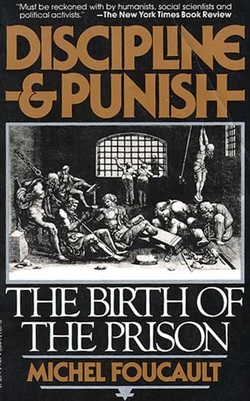Michel Foucault, Discipline and Punish: The Birth of the Prison

In Discipline and Punish, Michel Foucault presents a history of criminality and punishment that is rooted in disciplinary mechanisms that are, in turn, concerned with the creation of docile and productive bodies. Foucault writes against the popular notion that we have somehow “humanized” punishment by eliminating torture and focusing instead of trying to reform and rehabilitate criminality. He argues the opposite: that under the guise of humanizing punishment, we have instead extended our reach on the offender through creating subtle and barely noticeable mechanisms of surveillance that reproduce themselves not only in our institutions but also in the subjectification of the body itself. By moving away from trying to gain control over the criminal’s body (which was proving to not be as effective as originally planned anyway), we instead began to try to reform and control the criminal’s thoughts, aspirations, socialization and, subsequently, to make the criminal into a “normalized” subject in whom delinquency is both reinforced and eliminated as a result of punishment.
P. 24 – “Thus, by an analysis of penal leniency as a technique of power, one might understand both how man, the soul, the normal or abnormal individual have come to duplicate crime as objects of penal intervention; and in what way a specific mode of subjection was about to give birth to man as an object of knowledge for a discourse with ‘scientific’ status.”
Quick overview of the structure of the book:
· Torture as reparation for the crime that is ultimately an attack on the king’s sovereignty
· But merely physical punishment is not enough
· One must extract a truth—a confession—from the criminal, such that he becomes a lesson to the general public
· Now the offense is done not merely to the king, but also to the people as a social body
· The goal of incarceration then becomes to not only punish, but also to reform
· That’s where disciplinary power is born
· But it actually begins in other institutions before prison (the military, the school, the hospital, the workroom)
· Analyzing individual to construct a body of knowledge that helps to control them and mold them to become model citizens
· Prison becomes a microcosm of reforming the soul of the criminal through isolation, strict adherence to a prescribed schedule, silence, and hierarchical order
· A kind of positive power develops that hopes to motivate prisoners to either amend their sentence or receive other forms of reward
· The body is being trained to be in a highly hierarchical society with clear “normal” rules of conduct
· The Panopticon reverses the gaze of the multitude onto the criminal; now one central figure of the guard can observe all prisoners simultaneously instead of the criminal being observed by a multitude
· Constant surveillance that obscures the observer produces in turn a kind of self-discipline that leads to normalization: if you could be watched at any time, you are going to start watching yourself at ALL TIMES in order to avoid punishment and possibly procure rewards (p. 201)
· Prison reform only strengthens the grasp that disciplinary power has on the body: prison creates a “scientific” category of the delinquent as a member of a lower/poorer class such that illegalities perpetuated by the higher classes are not punishable or punishable in a different way (254-255)
· The invention of the category of “delinquency” as a kind of spiritual and moral favor justifies the existence of prison (256)
P. 24 – “Thus, by an analysis of penal leniency as a technique of power, one might understand both how man, the soul, the normal or abnormal individual have come to duplicate crime as objects of penal intervention; and in what way a specific mode of subjection was about to give birth to man as an object of knowledge for a discourse with ‘scientific’ status.”
Quick overview of the structure of the book:
· Torture as reparation for the crime that is ultimately an attack on the king’s sovereignty
· But merely physical punishment is not enough
· One must extract a truth—a confession—from the criminal, such that he becomes a lesson to the general public
· Now the offense is done not merely to the king, but also to the people as a social body
· The goal of incarceration then becomes to not only punish, but also to reform
· That’s where disciplinary power is born
· But it actually begins in other institutions before prison (the military, the school, the hospital, the workroom)
· Analyzing individual to construct a body of knowledge that helps to control them and mold them to become model citizens
· Prison becomes a microcosm of reforming the soul of the criminal through isolation, strict adherence to a prescribed schedule, silence, and hierarchical order
· A kind of positive power develops that hopes to motivate prisoners to either amend their sentence or receive other forms of reward
· The body is being trained to be in a highly hierarchical society with clear “normal” rules of conduct
· The Panopticon reverses the gaze of the multitude onto the criminal; now one central figure of the guard can observe all prisoners simultaneously instead of the criminal being observed by a multitude
· Constant surveillance that obscures the observer produces in turn a kind of self-discipline that leads to normalization: if you could be watched at any time, you are going to start watching yourself at ALL TIMES in order to avoid punishment and possibly procure rewards (p. 201)
· Prison reform only strengthens the grasp that disciplinary power has on the body: prison creates a “scientific” category of the delinquent as a member of a lower/poorer class such that illegalities perpetuated by the higher classes are not punishable or punishable in a different way (254-255)
· The invention of the category of “delinquency” as a kind of spiritual and moral favor justifies the existence of prison (256)